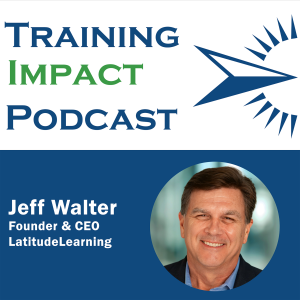
Friday Apr 18, 2025
2. Transform Your Training Program into a Strategic Asset
In the premiere episode of the Training Impact podcast, Jeff Walter, CEO of LatitudeLearning, breaks down how learning and development professionals can elevate their training programs into true strategic investments. At the heart of the episode is a challenge that many face: despite knowing the value of knowledge, L&D teams often struggle to secure executive buy-in and budgets. The key to reversing this trend? Understanding how executives think.
Executives categorize resources into two buckets: costs of doing business and strategic investments. Costs—such as accounting or legal departments—are essential but not growth drivers. Strategic investments, like sales or product development, are expected to yield returns. If training is viewed as a mere cost, budgets will stay lean. But if it’s repositioned as a revenue driver, it earns a seat at the executive table.
To achieve this, training leaders must start with the end in mind: What business outcome do you want to influence? Whether it's improving customer service rep retention or boosting first-call resolution rates, identifying the measurable impact is step one. From there, L&D teams can map out who needs to be trained, what they need to know and do, and the obstacles to delivering that training—be it technology limitations, global distribution, or learner access.
Walter outlines five levels of training programs that align with increasing ROI:
- Self-directed learning – Learners choose their path; impact is modest.
- Knowledge acquisition – Ensures learners know the right material.
- Skill development – Focuses on applying knowledge through coaching and practice.
- Individual performance – Training is tied to personal KPIs.
- Organizational performance – Programs align with company-wide goals and metrics.
Most companies operate in stages one or two, but the highest ROI comes as you move up. Don’t leap to stage five overnight. Instead, evolve gradually—first by validating knowledge acquisition, then layering in skills, performance data, and organizational alignment.
Execution hinges on ten essential training workstreams, ranging from configuring learners and content to managing assignments, progress tracking, and rewards. Particularly important is how success is measured. Going beyond course completions and satisfaction surveys, training should be evaluated based on impact. Ask: Are trained reps closing more calls? Are trained stores outperforming untrained ones?
One powerful approach is comparing performance between trained and untrained employees. This simple yet compelling narrative—demonstrating that trained staff drive better results—has a viral effect throughout an organization and strongly positions training as a growth enabler.
Walter closes with a real-world example: a franchise network undergoing bankruptcy used training levels as a deciding factor in which stores to retain. That’s the true mark of a strategic asset.
To move training from an afterthought to a driver of business success, L&D leaders must speak the language of impact. When training aligns with business goals and proves measurable ROI, it stops being a cost—and starts fueling growth.
Chapters
00:00 Transforming Training Programs into Strategic Assets
13:01 Planning and Implementing Effective Training Programs
22:58 Measuring Impact and Continuous Improvement
Keywords
training, strategic asset, executive mindset, resource allocation, training programs, business impact, performance measurement, continuous improvement, learning and development, ROI
No comments yet. Be the first to say something!